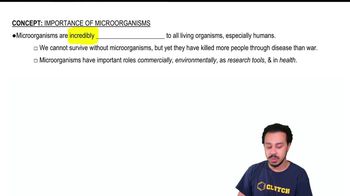Which of the following is not a characteristic of bacteria?
a. are prokaryotic
b. have peptidoglycan cell walls
c. have the same shape
d. grow by binary fission
e. have the ability to move
 Verified step by step guidance
Verified step by step guidance



Which of the following is not a characteristic of bacteria?
a. are prokaryotic
b. have peptidoglycan cell walls
c. have the same shape
d. grow by binary fission
e. have the ability to move
Which of the following is the most important element of Koch’s germ theory of disease? The animal shows disease symptoms when
a. the animal has been in contact with a sick animal.
b. the animal has a lowered resistance.
c. a microorganism is observed in the animal.
d. a microorganism is inoculated into the animal.
e. microorganisms can be cultured from the animal.
Into which field of microbiology would the following scientists best fit?
<IMAGE>
Recombinant DNA is
a. DNA in bacteria.
b. the study of how genes work.
c. the DNA resulting when genes of two different organisms are mixed.
d. the use of bacteria in the production of foods.
e. the production of proteins by genes.
Match the people in column A to their contribution toward the advancement of microbiology, in column B.
<IMAGE>
Which of the following statements is the best definition of biogenesis?
a. Nonliving matter gives rise to living organisms.
b. Living cells can only arise from preexisting cells.
c. A vital force is necessary for life.
d. Air is necessary for living organisms.
e. Microorganisms can be generated from nonliving matter.